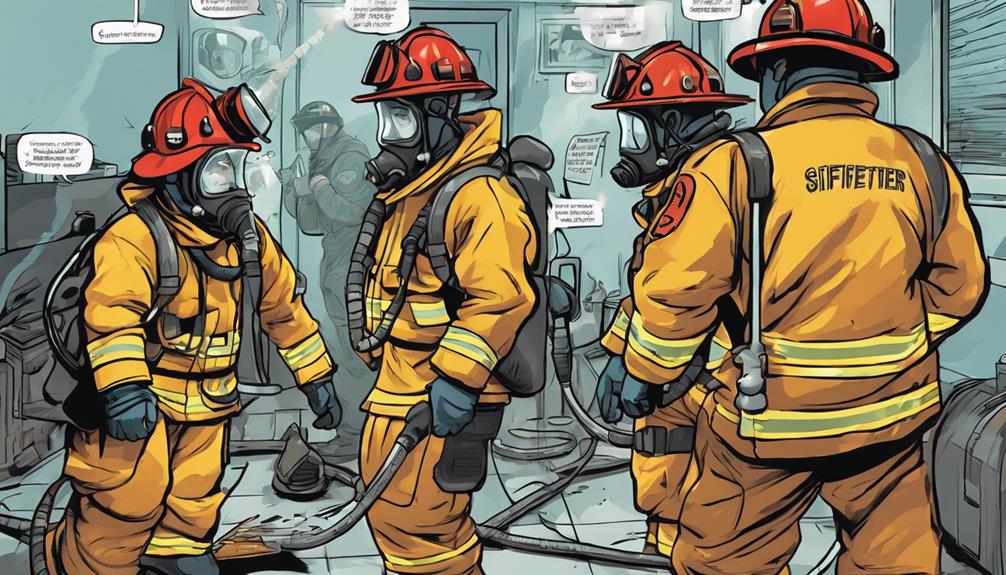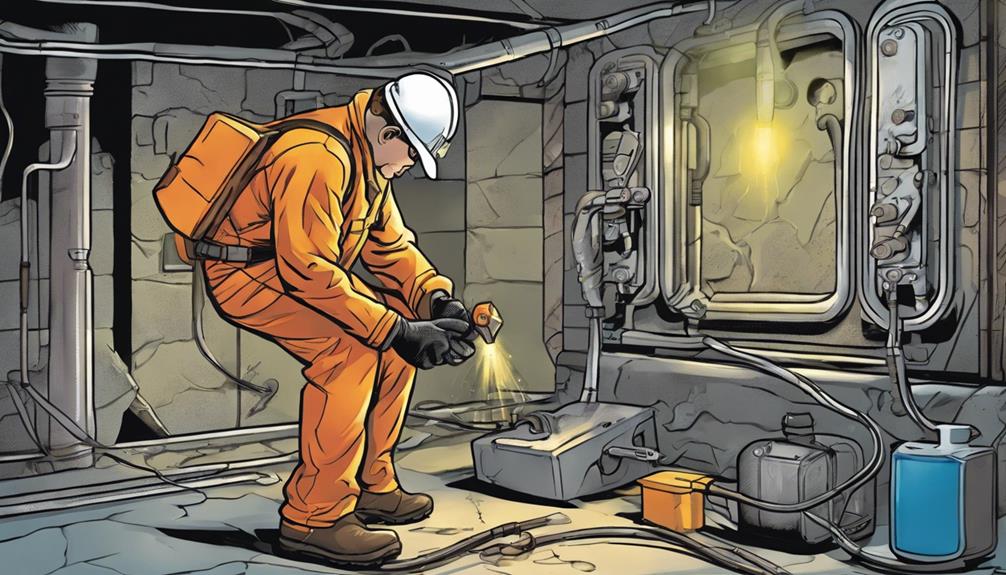To keep safe, detect gas leaks by using gas detectors with infrared or ultrasonic sensors. Early detection prevents fires and explosions. Signs like the smell of rotten eggs indicate a leak, so act fast. Regular inspections and proper detector maintenance decrease incidents. Gas detectors are vital in industrial, residential, and environmental settings. Advancements in technology boost gas detection systems, ensuring safety. Remember, prompt action is essential when it comes to potential hazards.
Key Takeaways
- Utilize gas detectors with infrared and ultrasonic sensors for accurate gas leak detection.
- Immediate response to gas leak signs like the smell of rotten eggs is crucial.
- Evacuate, shut off gas, and contact emergency services in case of a gas leak.
- Regular maintenance and calibration of gas detectors prevent potential hazards.
- Ensure proper ventilation, avoid sparks, and follow safety protocols to prevent fires and explosions.
Understanding Gas Detector Technologies
What makes gas detector technologies essential for ensuring safety in various environments?
Gas detectors play an essential role in safeguarding lives and property by detecting the presence of harmful gases. Sensors use various technologies like infrared and ultrasonic sensors to identify gas leaks promptly. Infrared technology is particularly effective in detecting hydrocarbon gases by measuring the absorption of infrared radiation. On the other hand, ultrasonic sensors excel in detecting gas leaks by analyzing sound waves produced by escaping gases. Together, these advanced technologies enhance the accuracy and efficiency of gas detectors, enabling quick responses to potential dangers.
Gas leak detectors equipped with these sensor technologies offer reliable detection capabilities, ensuring early warnings in industrial, residential, and commercial settings. By utilizing semiconductor sensors and electrochemical gas detectors, these devices provide precise measurements and sensitivity to a wide range of gases, enhancing safety protocols in diverse environments.
In the quest for improved gas detection instruments, projects like MINIGAS and Figaro Sensors continuously contribute to the innovation and evolution of gas detector technologies.
Importance of Gas Leak Detection

Gas leak detection plays an essential role in safeguarding the safety of individuals and properties by preventing potential hazards such as fires, explosions, and health risks associated with leaking gases.
Detecting gas leaks early can help you avoid serious consequences and protect your well-being. Signs like the smell of rotten eggs or hissing sounds indicate a potential gas leak that requires immediate attention.
Taking prompt action, including evacuating the area and seeking professional assistance, is pivotal to mitigate risks effectively. By implementing preventive measures such as regular inspections and installing gas detectors, you can significantly decrease the chances of gas leak incidents.
Stay vigilant and prioritize safety when it comes to gas leak detection to protect yourself and your surroundings.
Applications and Future Trends

Now, let's explore the exciting applications and future trends in gas detection technology.
From industrial uses to environmental monitoring, gas detectors play an essential role in various fields.
Advancements in photonics and sensor sensitivity are paving the way for more efficient and accurate gas detection systems.
Advancements in Detection Technologies
Incorporating cutting-edge detection technologies into gas safety systems is crucial for advancing overall safety measures and efficiency. The evolution of gas detectors is revolutionizing safety protocols in various industries.
Here are four key advancements in gas detection technologies:
- Photonics-based projects like MINIGAS: These projects are introducing smaller, high-sensitivity gas detectors that enhance safety measures by quickly identifying gas leaks in industrial settings.
- Optical-fiber-based sensors: These sensors play a pivotal role in measuring carbon dioxide exhaust emissions, showcasing the versatility of gas detection technologies across different applications.
- Research on sensitivity enhancement: Ongoing research focuses on improving the sensitivity of gas detectors to guarantee better performance and accuracy in diverse industrial applications.
- Integration of advanced technologies: Future trends involve incorporating advanced technologies into gas detection systems to enhance overall safety and efficiency, providing more effective monitoring of gas leaks and preventing potential hazards in industrial environments.
Future Trends in Gas Detection
Future trends in gas detection technologies encompass a broad range of applications and innovative advancements that are shaping the landscape of safety measures across various industries. As the demand for more reliable and efficient gas detection systems grows, integrating optical-fiber-based sensors and advanced technologies stands out as a key focus for enhancing safety protocols. These advancements aim to improve the sensitivity and accuracy of gas detectors, ensuring better performance in detecting potential hazards.
To provide a clearer picture of the future trends in gas detection, the table below highlights some key aspects shaping the industry:
| Future Trends in Gas Detection |
|---|
| Optical-Fiber-Based Sensors |
| Advanced Technologies |
| Enhanced Sensitivity |
| Improved Performance |
| Focus on Safety and Efficiency |
Calibration and Maintenance Practices

To maintain the reliability and accuracy of gas detectors, regular calibration and maintenance practices are essential. Here are some key points to keep in mind:
- Calibration Frequency:
- Portable detectors need more frequent calibration due to varying environments.
- Fixed gas detection systems may require quarterly, bi-annual, or annual calibrations for accurate readings.
- Routine Checks:
- Daily bump tests and monthly calibrations are common practices for portable gas detectors to uphold their reliability.
- Challenge Tests:
- These tests involve exposing detectors to known gas concentrations to verify performance and calibration accuracy.
- Effectiveness Assurance:
- Proper calibration and maintenance practices play an important role in ensuring that gas detectors effectively and accurately detect potential hazards.
Specific Gas Detection Technologies

Maintaining the reliability and accuracy of gas detectors involves utilizing specific gas detection technologies that cater to different monitoring needs and environments.
Various gas sensors, such as electrochemical sensors known for stability, catalytic bead sensors for explosive gases, and photoionization detectors essential for industrial hygiene, play pivotal roles in gas detection.
Infrared sensors, including point and imaging types, are commonly used in facilities with flammable gases due to their ability to detect gas properties through radiation absorption.
Additionally, ultrasonic gas leak detectors excel in leak rate detection by capturing acoustic emissions from gas expansion, making them ideal for outdoor environments like oil/gas platforms and gas turbine power plants.
Understanding the capabilities and advantages of these electronic gas detection methods is essential for ensuring the safety and security of different spaces where combustible gases may pose risks.
Natural Gas Safety and Risks

Guaranteeing the safe handling and usage of natural gas is paramount due to its widespread use across millions of American households and industries. Natural gas leaks can pose potential hazards, making gas safety an essential aspect to keep in mind.
Here are four vital points to bear in mind:
- Regular Inspection: Perform routine checks and maintenance of gas-powered appliances to prevent gas leaks and ensure secure usage of natural gas.
- Educate Yourself: Stay informed about the signs of a gas leak, such as the distinctive odor of rotten eggs and any unusual hissing sounds, to facilitate prompt detection and response.
- Symptom Awareness: Recognize the symptoms of gas exposure, including headaches, dizziness, and breathing difficulties, to identify and address gas-related health risks promptly.
- Exercise Caution: Handle natural gas exposure with care similar to other hazardous energy sources to maintain safety in both residential and industrial settings.
Detecting Gas Leaks at Home

You can detect gas leaks at home by recognizing the distinct smell of rotten eggs.
Listening for hissing sounds near gas appliances is another way to identify a potential gas leak.
Observing dead or discolored vegetation around gas lines can also indicate a gas leak.
These signs can alert you to potential health risks and prompt you to investigate further using detection methods to safeguard your safety and prevent any potential hazards.
Signs of Gas Leaks
Detecting gas leaks at home can be crucial for ensuring the safety of your household and property. Here are some signs to watch out for:
- Rotten Eggs Odor:
The distinctive smell of rotten eggs is often added to natural gas to help detect leaks easily.
- Hissing or Whistling Sound:
If you hear a hissing or whistling noise near gas appliances or pipelines, it could indicate a gas leak.
- Dead or Discolored Vegetation:
Keep an eye out for dead or discolored plants near gas lines as they could be a sign of underground gas leaks affecting vegetation.
- Bubbles in Water Sources:
If you notice air bubbles rising in water sources like ponds or puddles close to gas lines, it might suggest a gas leak allowing gas to escape into the water.
Being aware of these signs and symptoms can help you identify potential gas leaks early and take prompt action to address them, safeguarding your home and loved ones.
Health Risks
Gas leaks at home can pose significant health risks that vary in severity, from mild symptoms to potentially life-threatening consequences. The toxic properties of natural gas make it hazardous when inhaled, leading to potential health issues.
Mild symptoms of gas exposure include headaches, dizziness, nausea, and fatigue. However, prolonged exposure or high concentrations of gas can result in severe effects such as difficulty breathing, asphyxiation, and in extreme cases, explosions.
It's essential to be aware of these health risks associated with gas leaks to prioritize safety at home. Understanding the signs and symptoms of gas exposure can help in early detection and prevention of severe health complications.
Taking immediate action upon suspecting a gas leak is vital to safeguard against not only the risk of fires and explosions but also the potential health hazards that come with it. Regular maintenance and education on gas leak signs are key steps in ensuring the well-being of household members.
Detection Methods
Using a combination of various detection methods is crucial for effectively identifying gas leaks at home. To guarantee the safety of your household, consider the following methods:
- Electronic Detectors: These sensors are specifically designed to detect gases like methane or propane, providing a quick and accurate way to pinpoint potential leaks.
- Soap Solution: This simple yet effective method involves applying a mixture of water and soap to gas pipes. The formation of bubbles indicates the presence of a leak.
- Infrared Technology: Utilizing changes in infrared radiation emitted by escaping gases, this method is especially useful for pinpointing gas leaks with precision.
- Ultrasonic Detectors: These detectors listen for the distinct hissing sounds produced by gas leaks, making them valuable in noisy environments.
Combining these leak detection methods can help you promptly identify and address any potential gas leaks, safeguarding your home and loved ones from harm.
Emergency Response Procedures

In case of a gas leak emergency, your first priority should be evacuating the area immediately to a safe location. This step is vital for your safety and the safety of others.
Once you're in a secure place, the next important action is to shut off the gas supply at the main valve. This helps prevent further leakage and potential hazards.
It's essential to contact emergency services or the gas company promptly for professional assistance. Don't delay in seeking help from trained professionals who can address the gas leak effectively.
Remember to avoid using electronic devices or creating sparks as they can ignite the gas. Ensuring proper ventilation in the affected area is also key to reducing the concentration of gas and minimizing health risks.
Preventing Sparks and Ensuring Ventilation

To prevent sparks during a gas leak indoors, refrain from using electrical devices or open flames like matches or lighters.
Implement safety measures to avoid creating sparks near a suspected gas leak.
Make sure to evacuate the area immediately and guarantee proper ventilation to safeguard gas buildup.
Spark Prevention Measures
Spark prevention measures are essential for maintaining safety and preventing gas leaks in indoor environments. To uphold indoor safety and avoid potential hazards related to gas leaks, consider the following measures:
- Avoiding Open Flames:
Refrain from using matches or lighters in areas where gas leaks may be present, as these can easily ignite flammable gases like methane.
- Maintaining Proper Ventilation:
Proper ventilation helps prevent the buildup of natural gas indoors, reducing the risk of explosions due to gas leaks.
- Implementing Safety Protocols:
Have safety protocols in place to evacuate the area immediately upon detecting a gas leak and maintain proper ventilation to dissipate any accumulated gas.
- Conducting Regular Maintenance Checks:
Conduct regular maintenance checks on gas lines and appliances to detect and address potential leaks before they become hazardous.
Ventilation Importance
Proper ventilation plays a vital role in preventing sparks and ensuring gas safety indoors. Adequate ventilation helps to disperse any leaked gas, reducing the risk of ignition and potential disasters.
When dealing with a suspected gas leak, ensuring good airflow in the area is essential for minimizing the buildup of flammable gases and preventing hazardous situations. By ventilating the space effectively, you can decrease the chances of sparks igniting the gas, thereby enhancing indoor safety and mitigating potential hazards.
Remember, proper ventilation is key to maintaining a safe environment in case of a gas leak, as it helps to keep the air clear of gas buildup that could lead to dangerous situations.
Being mindful of ventilation not only prevents disasters but also promotes a secure indoor environment free from the risks associated with gas leaks.
Promoting Responsible Natural Gas Use

Make sure you promote responsible natural gas use by reporting any suspected gas leaks promptly to prevent potential hazards.
To secure safe and efficient utilization of natural gas, follow these vital guidelines:
- Install Carbon Monoxide Detectors: Given that natural gas is odorless, it's important to have carbon monoxide detectors in place to alert you to any potential leaks.
- Regularly Inspect Gas Lines: Check for signs of wear or damage in your gas lines to prevent leaks and ensure safe usage.
- Educate Yourself on Gas Leak Emergency Procedures: Understand what steps to take in case of a gas leak to safeguard yourself and your household.
- Maintain Appliances and Equipment: Proper maintenance of gas-powered appliances is crucial for their safe and efficient operation, reducing the risk of leaks or malfunctions.
Frequently Asked Questions
What Are the Safety Measures for a Gas Leak?
When a gas leak occurs, evacuate immediately to safety. Turn off the gas if it's safe. Avoid sparks or electrical devices. Contact emergency services or the gas company for help. Ventilate the area properly to disperse gas and reduce risks.
What Should You Do to Detect a Gas Leak?
Notice the distinct rotten egg smell or listen for hissing near gas lines. Look for dead plants or discolored vegetation. Check for air bubbles in water. Monitor high gas bills. These signs could indicate a gas leak.
What Procedure Must Be Followed When a Gas Leak Has Been Detected?
When a gas leak has been detected, evacuate the area immediately for safety. Avoid using ignition sources and contact emergency services or the gas company. Ventilate by opening doors/windows. Do not re-enter until deemed safe.
How Do You Control a Gas Leak Hazard?
To control a gas leak hazard, evacuate immediately for safety. Turn off the main valve to stop further leakage. Avoid sparks or flames that could ignite gas. Contact emergency services or the gas company for help. Wait for professionals to declare the area safe.
Are Solar Panels Compatible with Gas Leak Detection Systems for Safety Measures?
Yes, the best heavy duty solar panels can be compatible with gas leak detection systems for safety measures. The solar panels can provide a reliable and sustainable power source for the gas leak detection systems, ensuring that they are operational even during power outages.
Conclusion
You now understand the importance of gas leak detection and safety.
Did you know that in the United States, an average of 17 deaths per year are caused by gas leaks in homes?
By staying informed, regularly maintaining gas detectors, and following proper safety procedures, you can help prevent accidents and protect yourself and your loved ones from potential hazards.
Stay vigilant and stay safe!











